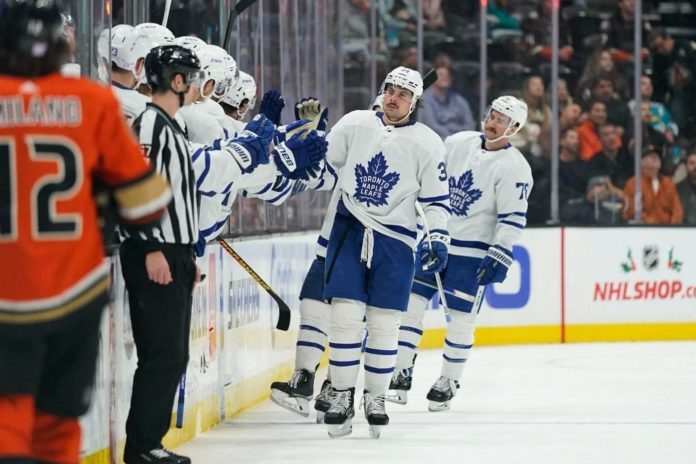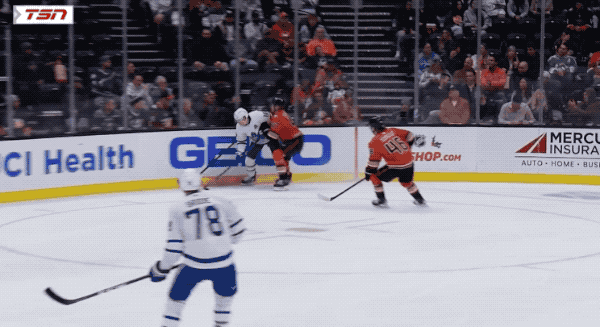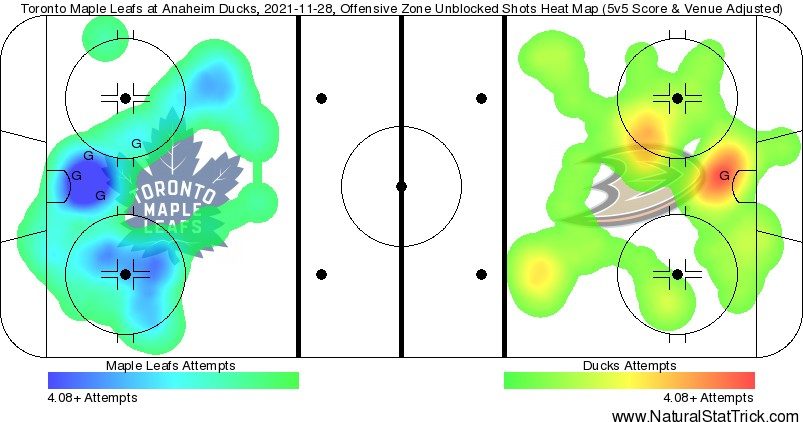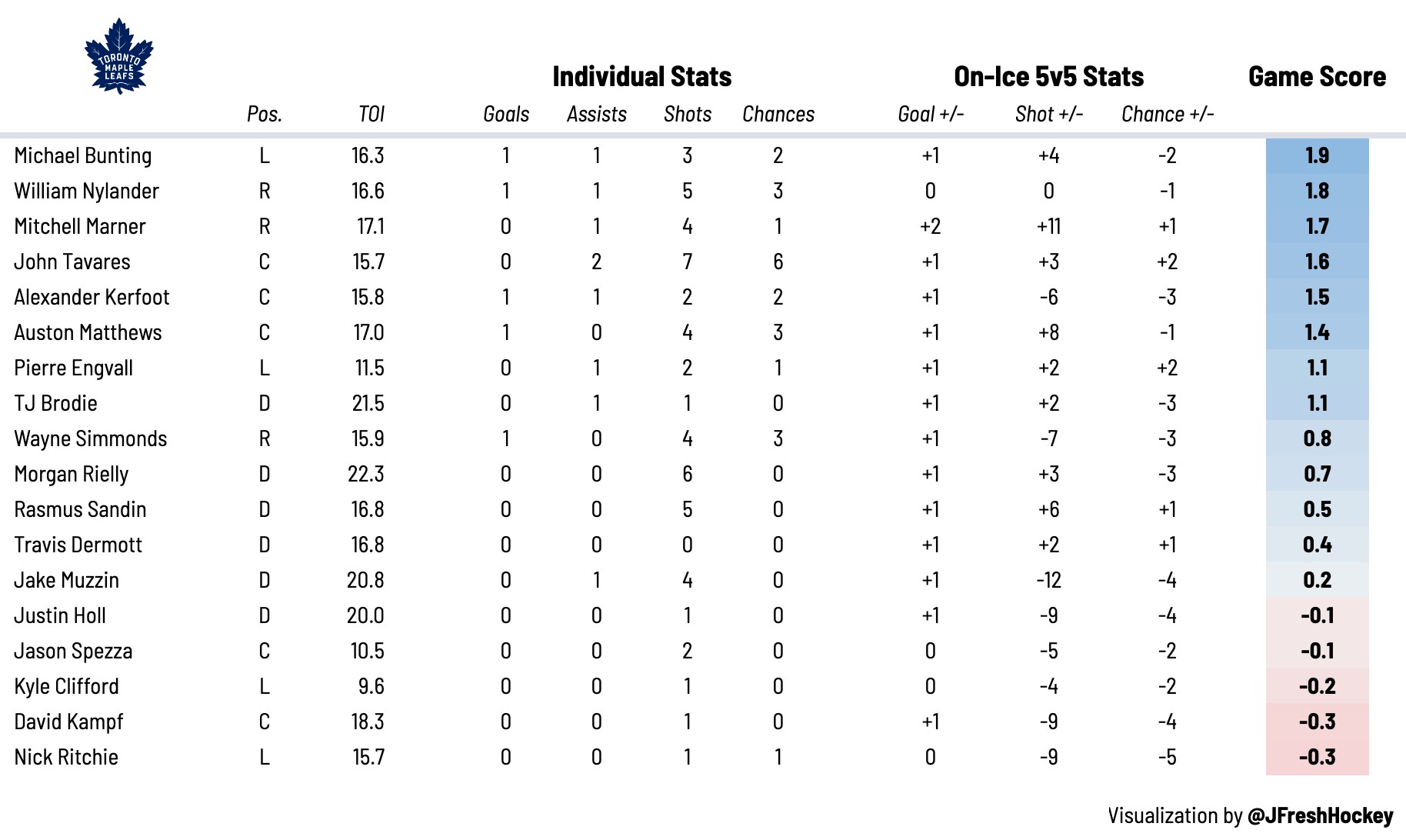
“Right now, they look like a machine!”
That was Ray Ferraro’s first thought after the final buzzer, and I can’t help but agree. Toronto has won 14 of 16 after last night’s 5-1 victory over Anaheim.
Wins are obviously nice, but personally, I try not to focus too much on which team scored more goals, instead putting most of my efforts into the predictive elements of play (i.e. which team is controlling play at 5v5?). Hockey can be quite the random sport, which is why it’s important to know if a team is following the right “process” en route to victories instead of relying on unsustainable swings in puck luck.
Well, the Leafs currently lead the league in scoring chances for at 5v5 — the most predictive metric for future goals — while ranking in the top five of scoring chance differential and shot differential. That puts them in the same neighbourhood as Florida, Carolina, and Calgary when it comes to controlling play at even strength.
Not only that, but Toronto ranks first in shot rate and scoring chance rate on the power play. They also have the third lowest shot rate against on the penalty kill. When you throw in the Vezina-calibre goaltending they’ve been receiving from Jack Campbell, it’s hard to find a legitimate weakness on this team right now.
That’s obviously not going to erase the sins of years past, with most fans screaming, “now let’s see them do it in the playoffs,” and I can certainly understand that sentiment. You can’t win a playoff series in November, though, so all we can do right now is analyze the games in front of us.
Toronto has been dominating those as of late, which should make this another exciting edition of grades to hand out. Buckle up Leafs fans, it’s time for some serious optimism. It’s time for some Leafs Report Cards!
5 Stars
Michael Bunting (LW, #58) — The concept behind locking up your star talent is that you can bring in a revolving door of role players to fill in the gaps. Rather than paying Zach Hyman the $5.5 million over seven years he got in free agency, you give one sixth of that AAV to a Michael Bunting over two years and hope he can provide much more than one sixth of Hyman’s value.
I think it’s safe to say he’s providing big-time value for Toronto right now. Not only is Bunting applying that Hyman-esque pressure on the forecheck by pinning his man to the wall and allowing his more talented linemates to come in and scoop out the puck, but he’s also making a few skilled plays offensively.
The quick passes he’s able to make to an open teammate help Toronto maintain possession and stay on offense. It’s also leading to much better point production than I would’ve expected from a player of Bunting’s pedigree. After picking up a goal on a tap-in from Marner and a secondary assist on Matthews’ deflection goal last night, Bunting is producing at a first-line rate in 2021-22.
Hyman has played three games fewer but if you account for ice time, Bunting still comes out on top.
Points/60 at 5v5:
Bunting: 2.45
Hyman: 1.77— Nick DeSouza (@NickDeSouza_) November 29, 2021
It’s worth mentioning that Hyman scored 1.79 Points per 60 alongside Matthews in over 2500 minutes together at 5v5. To keep the Bunting-Hyman comparison going, here’s a look at how well they control the run of play alongside Matthews.
Matthews with Hyman: 52 CF%, 56 SCF%, 55 xGF% (2500+ minutes together)
Matthews with Bunting: 61 CF%, 65 SCF%, 66 xGF% (174 minutes together)
For the uninitiated, CF% refers to shots, SCF% scoring chances, and xGF% expected goals.
There’s obviously some context to take into account here. As a team, the Leafs weren’t as good at controlling play under Mike Babcock as they have been under Sheldon Keefe. It’s also not necessarily fair to compare a teenage Matthews to the 24-year-old who’s in his prime right now.
All of that said, it’s remarkable that Bunting is currently performing better than Hyman did alongside Matthews in essentially every statistical category. Is he a better player than Hyman is right now? I don’t think anyone would argue that, but the evidence shows us that the Matthews line is performing better now than it ever has.
It’s the star players who dictate outcomes in this sport, but to say that Bunting doesn’t at least deserve some of the credit for Toronto’s first line dominance would be disingenuous at this point.
John Tavares (C, #91) — Even though we’re now several years into the Tavares era in Toronto, I am still appreciating more and more about his game and fit on this team. He’s so good at getting himself to the dirty areas and deflecting pucks with his absurd hand-eye coordination. If you ever got to watch Joe Pavelski play in his prime, it’s a similar phenomenon in that his defenseman always have the option to just float a wrister from distance, knowing there’s a good chance it gets redirected in front.
Statistically speaking, deflections are efficient shots that often result in rebounds, which are also among the highest percentage scoring opportunities in hockey. Tavares’ ability to create these chances out of basically nothing is such a valuable trait. Anytime his teammates are struggling to shed their man on the cycle, they can just launch a puck towards the net and Tavares can turn it into a good play.
His ridiculous hand-eye coordination also helps when it comes to stick-handling through a defense for clean breakouts and rush opportunities, but I wanted to narrow my focus to his net-front play. It’s such a crucial component to his offensive value.
TJ Brodie (RD, #78) — I’m always trying to measure things in hockey, which is why the defensive defenseman has always eluded me. We can look at large samples of a player limiting shots and scoring chances against, but on a more granular level, it’s Brodie’s ability to block passes through the middle of the ice that really stands out to me when I’m evaluating him.
We know that passes through the slot drastically improve your chances of scoring — basically tripling your expected shooting percentage — so a defender’s ability to take these passes away is extremely important. Brodie accomplished this on a few separate occasions Sunday night, getting his body and stick in the right position to block the slot pass.
He also poked a the puck free to help spring a 2-on-1 for Toronto — he actually did this twice. All of that helps make up for the fact that Trevor Zegras undressed him at one point. Zegras is one heck of a young talent, so I’d try not to take it too personally. Otherwise, Brodie was fantastic when defending the rush in 1v1 situations by maintaining a good gap and pressuring the puck-carrier right when they approached Toronto’s blueline.
4 Stars
Jack Campbell (G, #36) — The Leafs actually got outplayed in the first period and needed a bit of help from their goaltender to keep things close. Jack Campbell answered the bell early on, making a few big saves on Zegras and Sonny Milano from the slot. He also made a nice point-blank stop on an Adam Henrique power play chance in tight.
The Hampus Lindholm goal was a weird one where neither of his defenseman covered the Anaheim defenseman in the blue paint (more on that later), but otherwise, Campbell was perfect.
This whole “get Vezina-caliber goaltending” thing behind an offence that creates piles of chances, turns out it’s kind of an effective formula.
— Justin Bourne (@jtbourne) November 29, 2021
That’s a bold strategy, Cotton. Let’s see if it pays off.
Mitch Marner (RW, #16) — The most gifted passers in the world make it look easy. Marner feathering a saucer pass across to Bunting off the rush is a perfect example. He’s so good at baiting the defender in these situations; everyone in the building knows Marner wants to pass and he’s still able to do it. That’s when you know you’re good at something.
Marner made a few more creative passes last night that made me think back to the Jeff Marek quote, “he doesn’t make the right play, he makes the better play.” Marner often looks off an open player and waits an extra half-second before threading a teammate into open space who wasn’t even on your TV screen a second ago.
He also provided big-time value on the penalty kill, breaking up a seam-pass and clearing the zone.
The Kerfoot-Nylander Duo — I was ready to grade Alex Kerfoot near the bottom after his first two periods. He wasn’t making much of an impact in transition and his passing looked off, especially in the neutral zone. Then he scored on his opening shift in the third period. Later in the game, he made a nice play under pressure at 5v6 to get William Nylander up the ice for the empty netter.
Kerfoot has been beating NHL goaltenders clean from the slot a few times now. It’s definitely worth noting that his sky-high On Ice Sh% is wildly unsustainable, so we shouldn’t expect him to stay on this heater, in case that’s not obvious.
Nylander, on the other hand, is consistently generating quality chances that should lead to sustainable offense. At even strength, he’s using his speed to beat his man up the ice for rush opportunities. In fact, when you give him a chance to carry the puck at 5v4, he can do the same thing.
An underrated part of the PP vs PK matchup:
ANA's F1 chases behind the net to disrupt a potential double drop breakout, but TOR just skates with it, exploits the 1-2 at the line (as opposed to a 1-3) and gets a chance off the rush pic.twitter.com/u45bPEVT6s
— Jack Han (@JhanHky) November 29, 2021
3 Stars
Wayne Simmonds (RW, #24) — For the majority of the game I was a bit underwhelmed with Simmonds’ play. I loved his energy on the forecheck, in that he’s one of the only players I’d legitimately fear as an opposing defenseman going back on a loose puck. I didn’t love how often he was turning the puck over in transition.
In short, he had the passion but not the passing.
That’s okay, though, because he helped make up for it by finding the back of the net towards the end of the game by winning the race for a rebound. His drastically improved speed from last year has really helped him win more of those 50-50 pucks, and it’s resulted in him generating chances from in tight at a career-high rate.
It’s nice to see the pucks finally go in for him. He deserves it with the way he’s turned back the clock in 2021-22.
Pierre Engvall (RW, #47) — Was I blown away by Engvall’s game? No, but I also wasn’t furious, which can often be the case with him. One thing I wanted to point out was just how effective with puck retrievals. You don’t think of Engvall as a ferocious forechecker because he never uses his size to deliver a massive hit, but he’s actually one of Toronto’s best players at recovering loose pucks.
Even skilled teams like Toronto are forced to dump the puck in every so often, and more so in the playoffs. When that happens, Engvall becomes one of their more valuable players. Keep that in mind when you’re waiving him in your mock rosters.
Auston Matthews (C, #34) — I always find it funny when the Matthews line performs well, #34 has a few really good chances, scores a goal, and at the end of the day, I still find myself still wanting more. Maybe that’s the double-edged sword of expectations. We know what Matthews is capable when he’s on his A-game, so when he has a B-minus type of night it leaves us underwhelmed.
That said, Matthews scored another goal, which is what you pay him to do. This one came on a deflection, while Friday night’s was a rebound. Mike Kelly had a great tweet the other night breaking down how Matthews (and Alex Ovechkin) have been able to diversify their scoring.
Alex Ovechkin leads the league in even-strength goals & points. Only 1 of his 18 goals via PP 1-timer.
Auston Matthews leads the league in rebound scoring chances, 2nd in rebound goals.Two of the best goal scorers on the planet. Patented shots but also adaptable & versatile. pic.twitter.com/I2ZRbJPdLo
— Mike Kelly (@MikeKellyNHL) November 27, 2021
We know these two can rip one from distance and beat a goalie clean, which is what makes it so terrifying that they can also get themselves to different areas on the ice and still be just as dangerous. We don’t always see Matthews take advantage of his 6’3 frame, but take a look at how he boxes his man out and essentially “posts up” in front for what ends up being a pretty easy goal.
He’s finding ways to score from everywhere. Just wait until his 5v5 Sh% doubles (back to his career average).
Morgan Rielly (LD, #44) — I always find it funny when Rielly has a “quiet” night. That’s not who he is as a player, but in his 22-minutes of ice-time, I barely had any notes on him. He was making quick, efficient passes up the ice to his forwards and wasn’t jumping up in the rush as much as usual.
2 Stars
Nik Ritchie (LW, #20) — I could take the Keefe approach and cherrypick a few plays where Ritchie made a nice pass on the breakout — or I could take the objective approach and say he just didn’t play well, again. It’s frustrating to watch a player with his size be so ineffective on the forecheck. We’ve seen him lay a big hit or two in the past, but he’s avoiding contact when he pressures opposing puck-carriers, which just isn’t smart when you’re over 235 pounds.
Is his shooting percentage going to turn around? Yes, but I care way more about the little plays that lead to scoring chances and I’m just not seeing very many of them from Ritchie.
David Kampf (C, #64) — He was playing with Ritchie tonight and that line really got hemmed in at 5v5. How much of that is on Kampf? It’s tough to say because I thought he was doing his job more or less. I loved Kampf’s speed through the neutral zone; he’s really good at shielding the puck and transporting the puck up the ice.
Where he gets into trouble is when it’s time to make a play with the puck offensively. His linemates weren’t helping him in that department tonight, and when you defer more of the offensive responsibilities to Kampf, you’re going to have a bad time. I think it’s safe to say the third line was really missing Ondrej Kase.
The Ritchie-Kampf-Simmonds trio just doesn’t have the puck skills you need to generate passing plays off the rush.
Jason Spezza (C, #19) — One player who can make plays off the rush is Jason Spezza. He’s at his best when he comes flying in with a head of steam down the right wing. When he gains the zone with speed and winds up for his slap shot from the top of the right circle, you have to respect it. Last night, Spezza faked the clapper and tried making a quick pass to the middle, but he wasn’t able to connect on the pass. Aside from that lone-wolf rush, Spezza wasn’t able to create a whole lot offensively.
Kyle Clifford (LW, #43) — It looked like his first NHL game in a while. Clifford was fighting the puck for most of the evening, but still had the speed and forechecking ability you’d expect from a player who’s consistently had good 5v5 play-driving numbers throughout his career.
Personally, I really like the addition of Clifford to this group. He can provide an element of toughness and physicality on the forecheck that only Wayne Simmonds can match. When it comes to his fit in the lineup, though, he’s always been a good shot suppressor defensively and non-factor offensively. With that in mind, I wonder if he’d fit in better alongside Kampf in a defensive role rather than beside a skilled playmaker in Spezza.
The “Shutdown” Pair — I put that in quotations because they don’t appear to be shutting down too many players this season. Jake Muzzin did make a brilliant stretch pass up the ice to Marner, earning himself a secondary assist on the Bunting goal. The issue is that he also forgot about Lindholm in front of the net on Toronto’s only goal against.
I’d hate to have a referendum on a defenseman after every goal against. After all, hockey is a pretty random sport. With that in mind, I care way more about outshooting and out-chancing your opponents at 5v5. The Muzzin-Holl pairing didn’t do that last night, thanks to some rough moments on the breakout.
We’ve come to expect a few rough turnovers now and then with Muzzin, but Justin Holl is supposed to be the puck-mover who helps alleviate some of that pressure from his veteran partner. That hasn’t been the case this season. Holl looks hesitant with the puck on the breakout, struggling to complete passes up the ice despite playing with some of the most talented forwards in the league.
I still really like Holl’s 1v1 rush defense, but something has to give with this pairing when it comes to puck moving. They’ve spent way too much time stuck in their own end this season.
Heat Map
Here’s a quick look at where each team’s shots were coming from at even strength, courtesy of Natural Stat Trick.
Even after a rough first period, the Leafs managed to outshoot Anaheim at 5v5, controlling 53 percent of the shots. They also had 56 percent of the expected goals, which tells us their shot quality was superior last night, getting more good looks than their opponent from in tight.
Game Score
Game score is a metric developed by The Athletic’s Dom Luszczyszyn to measure single-game performance. You can read more about it here.
Tweets of the Night
This had nothing to do with the Leafs-Ducks game, but it’s everything that makes the internet great.
Sorry everybody, Morgan Freeman wasn’t available. But I found the next best thing. https://t.co/WvOcKffZSJ pic.twitter.com/T83zur4lv2
— John Cougar Colleencamp (A) (@BillTouspille) November 29, 2021
I have no words. I’m just so happy.
It’s baked in and justified that no one is going to give the Maple Leafs a break until they actually win a playoff series. Fair.
But it could have easily gone the other way so far this season. They look like a juggernaut right now. That’s not nothing.— Pierre LeBrun (@PierreVLeBrun) November 29, 2021
Oh no, he said the thing.
Auston Matthews doesn't give a single damn pic.twitter.com/Pt5y0jXj6y
— Omar (@TicTacTOmar) November 29, 2021
It turns out the NHL’s leader in 5v5 goal scoring since entering the league hasn’t forgotten how to score goals at 5v5. Maybe — just maybe — we could all do ourselves a favour and acknowledge that shooting percentage is A Thing.



































